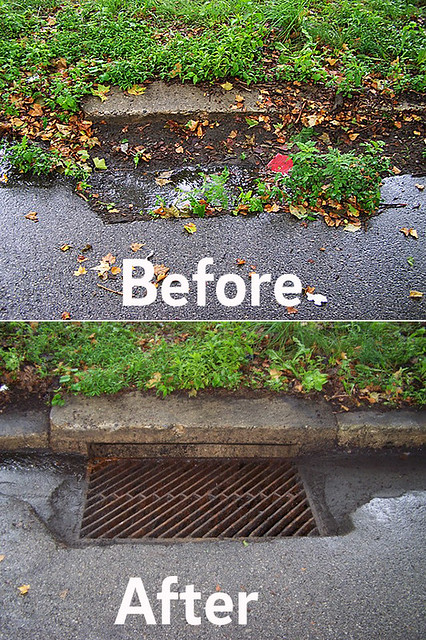While they may be easy to overlook, you can find at least one of our 75,000-plus storm drains on nearly every street in Philadelphia. Designed to take stormwater away from our streets, storm drains (or inlets) form a direct connection between our neighborhoods and the watersheds in which we live.
What does that connection mean? It means that, when people litter, leave pet waste behind, or let old cars leak oil in the street, that stuff washes down the storm drain and enters our water supply.
On the other hand, inlets blocked with trash, snow, leaves, construction debris and sediment can make local flooding worse when we have heavy rain and water can’t drain properly.
So, who takes care of our storm drains? And what can residents do to keep pollution out of our waterways and ensure the storm drains work properly?
Here to answer some of those questions during Infrastructure Week is William Shields, the head of our Inlet Cleaning Unit.
Watersheds Blog: Last year, your crews cleaned 100,354 storm drains. Even if you worked holidays and weekends, that’s nearly 275 storm drains per day! How many people does it take to keep our storm drains clean?
WS: We have about 23 two-person crews working during the day shift and five two-person crews during our night shift, so that totals around 56 people.
Watersheds Blog: How long have you been working on the storm drain crew, and what’s the craziest thing you’ve seen pulled out of an inlet?
WS: I have been with Philadelphia Water for the past 27 years and with the Inlet Crew for the last seven. Some of the craziest things we have found in our inlets include a car motor, false teeth, a skateboard, phones, guns, knives, drugs, wedding rings, cell phones and a variety of animals—including a mother duck and ducklings. We rescued the ducks and called the SPCA for that one.
Watersheds Blog: Sounds like a real zoo! How do you clean an inlet?
WS: First, we sweep up the debris. Then, we remove the inlet cover and use a big claw-like machine to clean out the inlet. It looks like a giant version of the claw game filled with stuffed animals at the arcade. Sometimes we open a fire hydrant and run water down the inlet to make sure it works
properly.Watersheds Blog: Do you have a schedule that determines which storm drains will be cleaned each week, or do you respond to reports of blocked storm drains?
WS: We have a computerized scheduling system that determines the most efficient way to clean all 75,000 inlets. We also receive complaints from 311 or through the Philadelphia Water hotline (215-685-6300) and we prioritize these requests over our scheduled work. It takes us about two days to respond to a complaint. Last year, we responded to 4,000 cleaning requests.
Watersheds Blog: Wow, that is impressive! What is the most common cause of a blocked storm drain?
WS: Garbage and debris thrown into our inlets.
Watersheds Blog: What should a person do if they see a blocked storm drain on their street?
WS: Call 215-685-6300 with the exact location of the inlet.
Watersheds Blog: Any storm drain maintenance tips for residents or community groups involved in volunteer cleanups?
WS: “Out of sight out of mind” is not a good motto to follow. Many people sweep debris into the storm drains to clean the street, and they don’t realize they are causing a problem. The more that we prevent litter and other debris from entering our stormwater system, the cleaner our waterways and environment will be for future generations.
Big thanks to William and his crew for keeping our inlets clear and to the call center for taking so many customer calls!
Want to help spread the word about keeping trash, debris and harmful chemicals out our storm drains? Visit our Storm Drain Marking page and sign up for a free kit featuring your local watershed and an aquatic critter native to local waterways!
Volunteers in 9 neighborhoods marked storm drains during #PhillySpringCleanUp! Thank you! https://t.co/aK21VSOWaB pic.twitter.com/wJi9Gg6zMM
— Philadelphia Water (@PhillyH2O) April 19, 2016
